A short
guide and history of St Leonard's Church
(compiled by Steve Goodsell)
This page is currently under development,
so please bear with us - any information or corrections
may be sent to the webmaster at webmaster@stleonardsdeal.co.uk
INTRODUCTION
St Leonard's is still the Parish Church of Deal, despite now lying on the outskirts of the
town and there being several other churches within the town. It gains its name from the
Saint to whom it is dedicated - St Leonard of Limoges an Abbot who lived in France during the 6th
century and who is now the Patron Saint of Prisoners.
Today, St Leonard's serves the local community as the
mother church of a Benefice (group of churches) which includes three other local churches;
St Richards, Mill Hill; St Nicholas, Sholden; and St Martins, Great Mongham. Services are
held several times a week in all four churches, with each church having its own unique
look and feel. 
Although some sources give credence to a place of worship having been on the site since
Saxon times, no evidence of this building exists now, however parts of the current
Church of St Leonard's certainly date to approximately 1100 although over the centuries
since, it has seen many alterations. This leaves the building now standing, as a confusion
of architectural styles. The Nave and chancel contain the earliest remaining
arcitecture, with the original tower being added some 80 to 100 years later.
The chancel was remodeled in the 13th century, and during this period the narrow north
and south aisles were enlarged and doors added to each (These doors are both now gone,
although the southern can be detected in the outside wall and parts of the northern
doorway were reused in the current north door, leading from the early 19th century
extension to the church, into the north porch.)
The current tower is of 17th century construction (completed in 1686) having been built
to replace the 12th century one which had collapsed due to the church falling in to ill
repair prior to the reformation. Many other repairs and alterations have obviously
occurred over the centuries and in this history, I will try and lead you through them and
show how they have influenced what we have today.
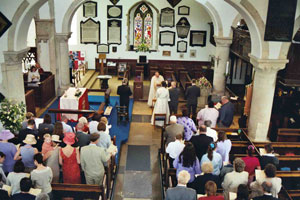 While this amalgam of architectural styles has led
to what some would call an aesthetically unattractive building, certainly from the
outside, as evidenced in the picture above, it has along with various changes in
fashion and the foibles of its congregations over the ages, led to an intriguing, if no
less confusing, interior. This is very lopsided and results in the bulk of the
congregation facing south, rather than the traditional east and therefore sitting side on
to the Altar. While this amalgam of architectural styles has led
to what some would call an aesthetically unattractive building, certainly from the
outside, as evidenced in the picture above, it has along with various changes in
fashion and the foibles of its congregations over the ages, led to an intriguing, if no
less confusing, interior. This is very lopsided and results in the bulk of the
congregation facing south, rather than the traditional east and therefore sitting side on
to the Altar.
The picture alongside is a view from the gallery over the north door and shows how the
orientation leaves the choir and high altar hidden in the chancel off to the left and the
congregation facing the end of the new altar which has been installed forward of its more
usual position. One Bishop is said to have commented that it is "The most
cockeyed church in Christendom". It does however mean that the church contains
features of architectural importance and interest spanning nine centuries.
THE TOWER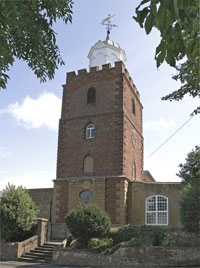
The current tower is surmounted by a cupola which featured on charts as an important
landmark for ships approaching the Goodwin Sands. This cupola has recently been completely
refurbished, at a total cost in excess of £69,000.
The original 12th century tower that collapsed in the mid 17th century had possessed a
steeple ( at least according to Philip Symond's Map of Kent which can normally be relied
upon in these matters. I am not aware of any pictorial evidence either way)
The tower now has a clock on the north and south faces and a peal of six bells.
Originally there was a peal of five, first cast and hung in 1686. These were recast in
1887, with a sixth bell being added, as a jubilee gift (interestingly to the town rather
than the church) from Captain George Coleman who later became mayor of Deal. The
current clock is dated 1866, the earliest record of the tower having a clock is for 1715,
but the current one dates from 1866.
THE CHURCH INTERIOR
One normally enters St Leonard's via the west door in the tower, however the north door to
the church is available to to give access for wheel chair users etc and also serves as the
entrance for the bride at weddings as it allows her a longer procession, passing through
the congregation.
Once through the main doors of the tower, the visitor passes down several steep steps into
a lobby notable for a spiral staircase to the bell tower and two hatchments (those
numbered 12 and 15 in the separate
article) The table on which the Deal Charter was displayed after its signing by
William III in 1699 also stands here. It is also worth noting the insides of the entrance
doors and the large lock, which are probably original to the present tower
. If you are lucky and the inner doors into the body of the church are open and the sun
shining in the right direction, you will be struck by the splendour of the view this
allows of the altar, chancel and ascension window. Unfortunately, they are normally kept
closed to help keep the heat in and drafts out. 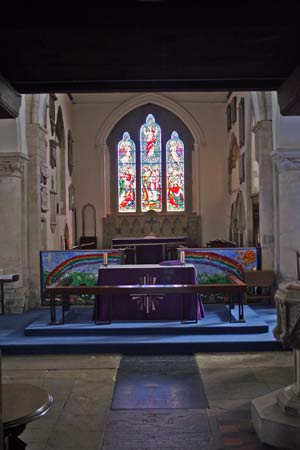
As you enter the main body of the church, take time to look back the way you came; as
well as the modern interior doors, you will have passed by an earlier door which is a fine
example of Jacobean panelled work complete with a hand wrought latch and bolt. This door
is now kept open, but it is worth closing it as far as possible, to better view its
splendour from both sides.
Once inside the main body of the church, you begin to sense the "ordered
chaos" that has resulted from the many extensions. To the south the aisle is still
the width it became when the church was expanded in the 13th century, the northern aisle
however was extended both in the 13th century to a similar width to that of the current
south, and again in the 19th century, which created the current lopsided interior. Prior
to the Reformation, St Leonard's, in common with most churches had many side altars and
images of Saints, where candles were kept burning in both these aisles, these are all now
gone..
It should be noted that the extensions of the 13th C were not symmetrical, the south
aisle was always longer than the north, both to the east where the Lady Chapel altar now
stands and to the west where it stretches almost as far as the west wall of the tower.
Part of this was divided off to form the clergy vestry in 1709 and a further section in
1979.
The second extension to the northern aisle took place in 1819 when the whole north wall
was taken down and the current dimensions reached. It was with the building of this
extension that the pews in the northern aisle were turned to face south so giving the bulk
of the seating in St Leonard's a most unusual orientation. For a long period of time after
this it meant that any acts of worship carried out at the main altar in the chancel were
hidden from the bulk of the congregation.
In 1979 this changed. Worship was becoming much more centred around Holy Communion and
moving away from people attending church primarily to hear the clergy preaching, so
leading to a bigger need for people to be able to see the altar. Rather than a wholesale
redesign of the seating, screens at the front of the chancel were moved and placed on the
walls of the vestry, the pulpit which stood by the side of the small 15th century door
linking the chancel and northern aisle was removed and a new, forward altar and communion
rails placed where they stand today, just outside the chancel (see picture right) At
the same time several pews were removed, leaving an open space from the altar to the west
door. It was also at this time that a further section of the western end of the south
aisle was partitioned off to increase the size of the vestry and provide today's
toilet and kitchen facilities, such as they are.
THE GALLERIES
Standing in front of the altar and looking around
the church, another feature stands out apart from the unusual shape - the galleries.
St Leonard's is rare, if not unique as a parish church, in having galleries from
three different periods still intact. Galleries were another way of meeting the needs of
the expanding population of Deal over the centuries and these, as with the basic structure
of the church have evolved several times over the years.
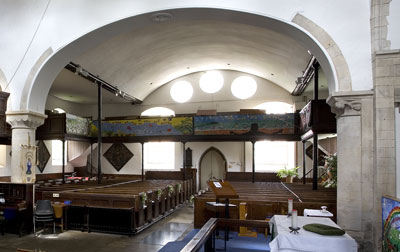 The Georgian gallery over
the north aisle is contemporary with the extension (1819) and is rated as being of great
significance by the Georgian Society among others as an excellent example of its type.
Although at first glance the benches and kneelers in this gallery appear quite sad, they
are for the most part original and I am told by the Georgian Society, well worth
retaining. This picture shows the North aisle. The original extent of the aisle was as far
as the two iron pillars which now support the ceiling. The georgian gallery runs round
three sides of the new extension. The bulk of the panneling is unfortunatly concealed
behind murals currently, but I hope to be able to take a picture with these temporarily
removed in the near future, The Georgian gallery over
the north aisle is contemporary with the extension (1819) and is rated as being of great
significance by the Georgian Society among others as an excellent example of its type.
Although at first glance the benches and kneelers in this gallery appear quite sad, they
are for the most part original and I am told by the Georgian Society, well worth
retaining. This picture shows the North aisle. The original extent of the aisle was as far
as the two iron pillars which now support the ceiling. The georgian gallery runs round
three sides of the new extension. The bulk of the panneling is unfortunatly concealed
behind murals currently, but I hope to be able to take a picture with these temporarily
removed in the near future,
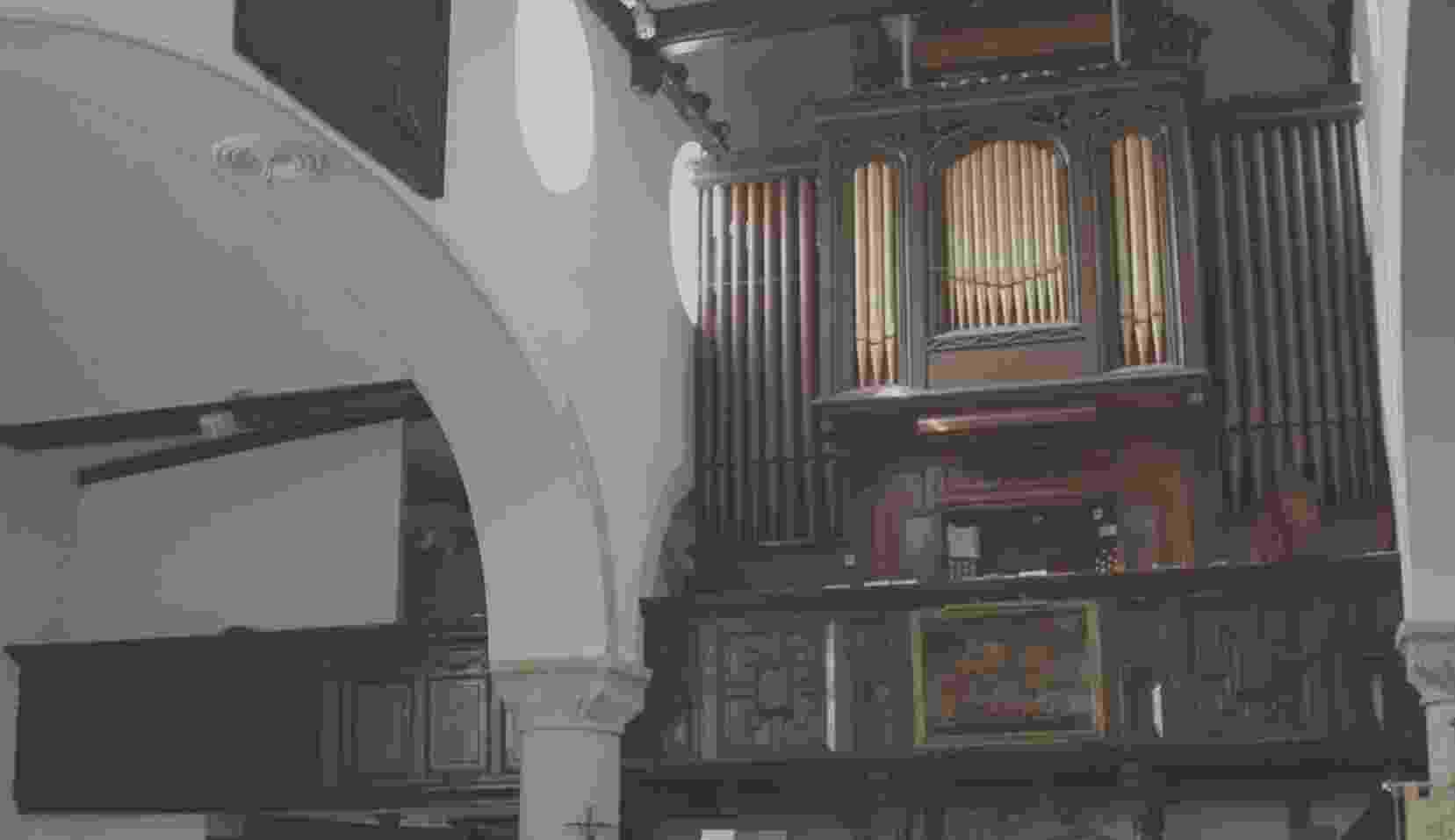
The gallery which now houses the Bevington Organ is known as the Pilots Gallery and while not the
original, which suffered when the tower collapsed, still dates to 1705 and is clearly of
'Restoration period' style. On the front, either side of the picture of an 18th
century Man O' War can still be seen the inscription from its most recent rebuild
and some interesting paintings of the globe and pilots in traditional uniform although
these are now much faded. The date shown on the picture of 1705 is the date of
painting, rather than the Great Storm of 1703 which it commemorates, where some 1,200 men
were lost on the Goodwin Sands.
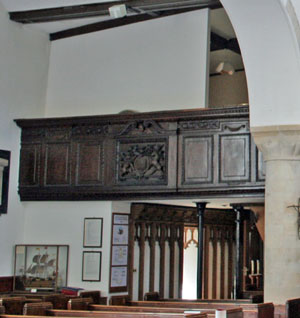 The final gallery is Victorian, erected
in 1860 over the entrance to the vestry, and of interest for several reasons. The front
bears the carved Arms of William III (after Mary's death) which had originally been on the
front of a gallery built in 1696 by Thomas Bowles (who later became Mayor of Deal) which
sat over the chancel until it was removed in 1860. The old Gallery is believed to have
been made of panels from Northbourne church. Incidentally, it was at this time (1860) that
the old 'horsebox' pews were replaced with those we now have. The picture to the left,
shows not only the gallery, but also the screening that was removed from the front of the
chancel when that area was reordered in 1979. Was it a quirk of fate or a plan which
brought the gallery and the screens which for many years had existed in close proximity
back together after almost 120 years? The final gallery is Victorian, erected
in 1860 over the entrance to the vestry, and of interest for several reasons. The front
bears the carved Arms of William III (after Mary's death) which had originally been on the
front of a gallery built in 1696 by Thomas Bowles (who later became Mayor of Deal) which
sat over the chancel until it was removed in 1860. The old Gallery is believed to have
been made of panels from Northbourne church. Incidentally, it was at this time (1860) that
the old 'horsebox' pews were replaced with those we now have. The picture to the left,
shows not only the gallery, but also the screening that was removed from the front of the
chancel when that area was reordered in 1979. Was it a quirk of fate or a plan which
brought the gallery and the screens which for many years had existed in close proximity
back together after almost 120 years?
THE STAINED GLASS
The church has four main stained glass windows, which I have depicted
below, all I believe dating in the last half of the 19th C and the early 20th C.
There are three other stained glasss windows, as well as the main four - in the north and
south walls of the Chancel (these are just patterned) and another very small window
depicting a lamb high up in the wall above the main Altar. I can give no idication of date
for these, but again pictures are shown below.
As you can tell, I am afraid I do not know much at all about any of the stained glass,
so if any kind reader has other information they would like to pass to me, I would be
grateful.
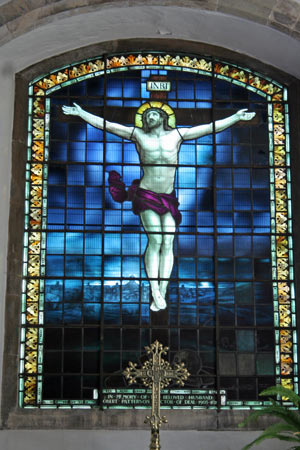 |
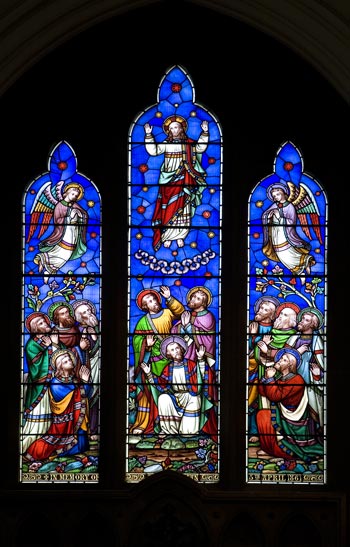 |
| The Crucifixion window in the
Lady Chapel, is a copy of a painting by Guido Reni and is in memory of the Reverend R
Patterson who was Rector at St Leonard's between 1905 and 1919 |
The Ascension
Window in the Chancel, based on Luke Ch 24 v50-53 is dedicated to Mrs Anne Oldman who
during her life was probably the greatest benefactor of St Leonard's. She gave the
Bevington Organ to the church as well as funding many improvements and repairs to the
fabric of the building. |
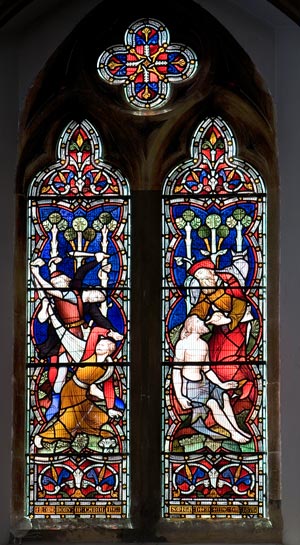 |
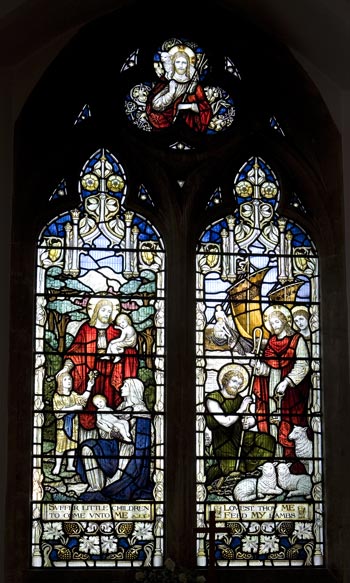 |
The Good Samaritan window,
based on Luke Ch10 v30-37 is in the middle of the south wall of the church |
In the east wall of the north
aisle is a window where the left hand pane is based on Matthew Ch 19 v 14 'Suffer little
children to come unto me' and the right hand on John Ch 21 v 15-16, 'Lovest thou Me, feed
my lambs (Spoken to Peter on the third time Jesus appeared to his disciples after rising
from the tomb) |
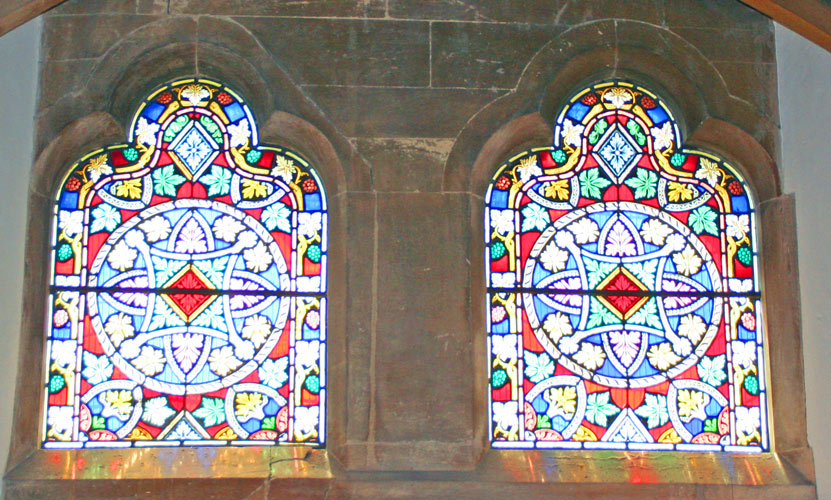 |
The three other windows within the Chancel.
<=== South wall
North wall==>
.... and the lamb which is above the Ascension window
|
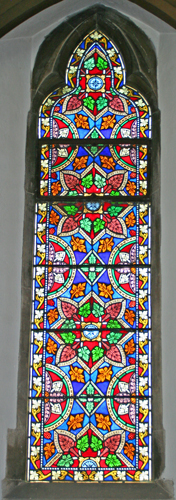
|
|
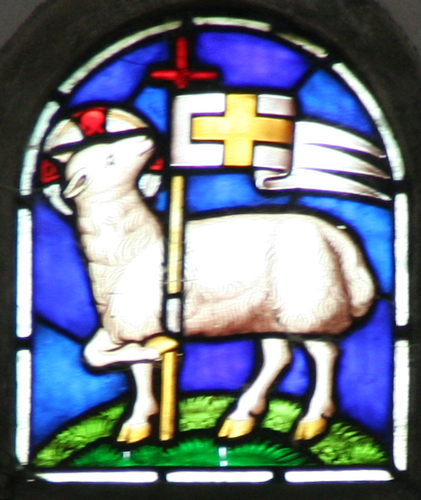 |
NOTABLE FEATURES OF THE CHURCH
As you will have gathered, St Leonards is rich in
the variety of its features, fixtures and fittings and some of them I have mentioned in
passing. As time has moved on each generation has left something behind for the next to
admire and no generation has felt the need to expunge all trace of another. It
is this diversity which makes the church such a valuable historical record of the last 800
years.
Here I will attempt to list - and over time
illustrate and describe - as many of these features as possible. Their order will be as
far as practicle, that in which you would see them if entering the chuch by the tower and
proceeding in a clockwise fashion round the building.
| Outer Tower doors |
Notable for the inner skin and original lock dating to the rebuilding in
1686 |
| Deal Charter
Table |
Stands
in the base of the tower and is the table upon which the Charter was laid when signed in
1699 |
| Inner Tower door |
A
single leaf jacobean door of particularly fine construction, with original hand
wrought latch. While left in situ it is obscured by the modern double doors, which the
church are considering replacing with glass doors - It is worth stopping to examine this
door! |
| The Hatchments |
The
first two are in the tower base, others hang on almost every wall of the church. |
| The Stained Glass windows |
The
ascension window is seen straight in front immediatly on entering the church, the other
main windows can also be viewed once the body of the church is entered. - Described above. |
| The Galleries |
You
enter the church from under the Pilots gallery. This and also the
others are described above. |
| The North Door |
Contains
some of the stone work from the original north door. |
| Queen Anne's Arms |
After
the Restoration in 1660 the Royal Arms were ordered to be placed in all churches. In the
wall above the extended arch to the nave, is a board showing the coat of arms of Queen
Anne, this is best seen from the Georgian gallery. It is currently difficult to make much
of the detail out, but it is hoped to restore this board in the near future. |
| The Chancel |
This area contains many
features of interest, which I describe below .... |
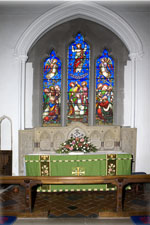 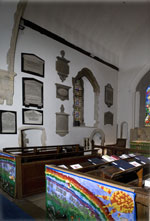 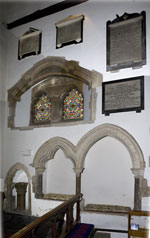 |
15th Century
door |
Used by the
Priest to gain easy access to the pulpit which used to stand nearby |
| Norman Piscina |
At least as old
as the church, this octagonal shaft, carved with chevron mouldings and topped by an
elaborate capital, this is among the finest of its type in southern England |
| 13th Century Sedilla |
With shafts
constructed of Purbeck Marble, these stone seats in the southern wall of the chancel would
have accomodated the clergy during services. The crowned head of a King rests at the foot
of the right arch. Legend has it that this stems from an overnight stay in the church by
King Richard and his knights when returning via Sandwich from the Crusades. Certainly the
style and look of it support this theory. |
| Two recesses in
north east corner |
The wider of
the two (on the north wall) is an ancient Aumbry - a recess where sacred vessels would
have been kept. The taller, narrow one probably held a statue of St Leonard |
| Memorial
tablets and tombstones |
There are many
memorial tablets mounted on the walls throughout the church and also several tombstones
set in the floor. Most here in the chancel commemorate previous rectors and their
families. |
| Baker Brass |
To the North of
the High Altar, set in the floor is a series of brasses marking the grave of Thomas Baker
(or Barbor) who died in February 1508. They show his wife, their four sons and four
daughters as well as Thomas himself. A rubbing hangs nearby. |
| Chrism Brass |
Under the High
Altar is an unusual example of this type of brass (commemorating the lfe and death of a
newly baptised child) This one is for Anne the daughter of Thomas Constant, Parson of deal
and dates to 1606. |
|
|
|
To be
continued |
|
|
|
|
|
|
|
|
|
|
|
|
|










 While this amalgam of architectural styles has led
to what some would call an aesthetically unattractive building, certainly from the
outside, as evidenced in the picture above, it has along with various changes in
fashion and the foibles of its congregations over the ages, led to an intriguing, if no
less confusing, interior. This is very lopsided and results in the bulk of the
congregation facing south, rather than the traditional east and therefore sitting side on
to the Altar.
While this amalgam of architectural styles has led
to what some would call an aesthetically unattractive building, certainly from the
outside, as evidenced in the picture above, it has along with various changes in
fashion and the foibles of its congregations over the ages, led to an intriguing, if no
less confusing, interior. This is very lopsided and results in the bulk of the
congregation facing south, rather than the traditional east and therefore sitting side on
to the Altar.

 The Georgian gallery over
the north aisle is contemporary with the extension (1819) and is rated as being of great
significance by the Georgian Society among others as an excellent example of its type.
Although at first glance the benches and kneelers in this gallery appear quite sad, they
are for the most part original and I am told by the Georgian Society, well worth
retaining. This picture shows the North aisle. The original extent of the aisle was as far
as the two iron pillars which now support the ceiling. The georgian gallery runs round
three sides of the new extension. The bulk of the panneling is unfortunatly concealed
behind murals currently, but I hope to be able to take a picture with these temporarily
removed in the near future,
The Georgian gallery over
the north aisle is contemporary with the extension (1819) and is rated as being of great
significance by the Georgian Society among others as an excellent example of its type.
Although at first glance the benches and kneelers in this gallery appear quite sad, they
are for the most part original and I am told by the Georgian Society, well worth
retaining. This picture shows the North aisle. The original extent of the aisle was as far
as the two iron pillars which now support the ceiling. The georgian gallery runs round
three sides of the new extension. The bulk of the panneling is unfortunatly concealed
behind murals currently, but I hope to be able to take a picture with these temporarily
removed in the near future,
 The final gallery is Victorian, erected
in 1860 over the entrance to the vestry, and of interest for several reasons. The front
bears the carved Arms of William III (after Mary's death) which had originally been on the
front of a gallery built in 1696 by Thomas Bowles (who later became Mayor of Deal) which
sat over the chancel until it was removed in 1860. The old Gallery is believed to have
been made of panels from Northbourne church. Incidentally, it was at this time (1860) that
the old 'horsebox' pews were replaced with those we now have. The picture to the left,
shows not only the gallery, but also the screening that was removed from the front of the
chancel when that area was reordered in 1979. Was it a quirk of fate or a plan which
brought the gallery and the screens which for many years had existed in close proximity
back together after almost 120 years?
The final gallery is Victorian, erected
in 1860 over the entrance to the vestry, and of interest for several reasons. The front
bears the carved Arms of William III (after Mary's death) which had originally been on the
front of a gallery built in 1696 by Thomas Bowles (who later became Mayor of Deal) which
sat over the chancel until it was removed in 1860. The old Gallery is believed to have
been made of panels from Northbourne church. Incidentally, it was at this time (1860) that
the old 'horsebox' pews were replaced with those we now have. The picture to the left,
shows not only the gallery, but also the screening that was removed from the front of the
chancel when that area was reordered in 1979. Was it a quirk of fate or a plan which
brought the gallery and the screens which for many years had existed in close proximity
back together after almost 120 years?